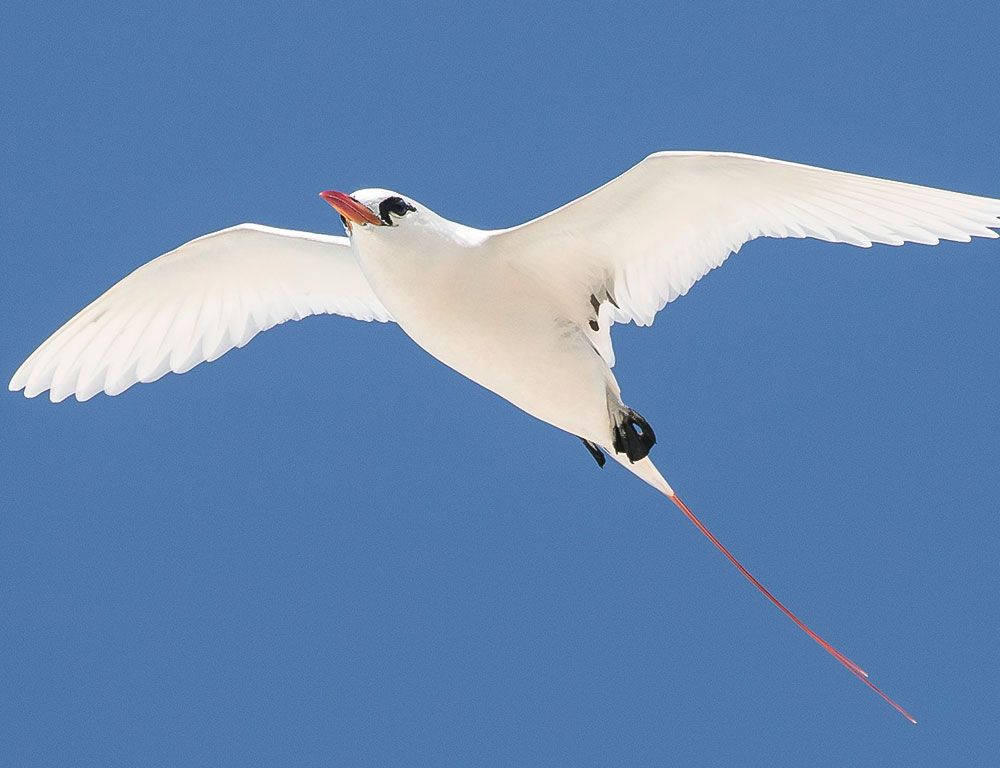The Red-tailed Tropicbird (Phaethon rubricauda) is a nice seabird embodying tropical beauty and grace.
With its striking white plumage, contrasting black wingtips, and attractive red tail feathers, this avian species commands attention as it soars effortlessly over the vast expanses of the world’s oceans.
Known for its aerial prowess and elaborate courtship displays, the Red-tailed Tropicbird symbolizes elegance and resilience in its remote island habitats.
From its remote nesting sites on rocky cliffs to its skillful hunting techniques over the open ocean, this magnificent bird captures the imagination of birdwatchers and nature enthusiasts alike.
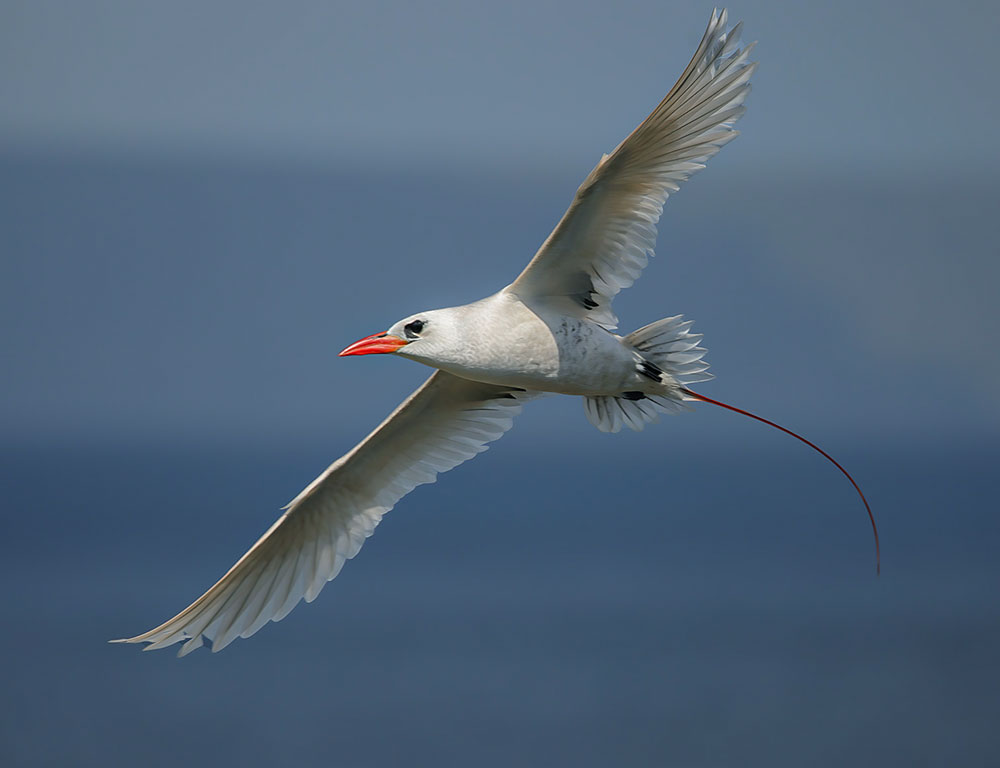
Characteristics Of Red-Tailed Tropicbird
The Red-tailed Tropicbird (Phaethon rubricauda) is a stunning seabird known for its striking appearance and graceful aerial maneuvers.
Found worldwide in tropical and subtropical regions, these birds possess several distinctive physical characteristics that make them stand out in their environment.
Plumage
Red-tailed Tropicbirds exhibit predominantly white plumage with contrasting black markings on their wings and tail. The vivid red coloration of their long, tapering tail feathers is particularly striking against the backdrop of their white body.
Bill
Their slender, slightly curved bills are designed for capturing prey in flight. Adapted for catching fish, squid, and other small marine creatures, the bill of the Red-tailed Tropicbird is ideal for swift and precise strikes.
Tail Feathers
As indicated by their name, the most notable feature of these birds is their long, red tail feathers, which can extend up to half a meter in length. These feathers play a crucial role in their courtship displays and are also used for steering during flight.
Wingspan
Red-tailed Tropical Birds boast impressive wingspans, measuring up to a meter in length. Their long, narrow wings are perfectly suited for effortlessly gliding over the ocean’s surface as they search for food or engage in aerial acrobatics.
Crest
These birds have a distinctive white crest atop their heads, which they can raise or lower depending on their mood or level of alertness. This crest adds to their overall regal appearance and helps them stand out against the backdrop of the sky.
Legs And Feet
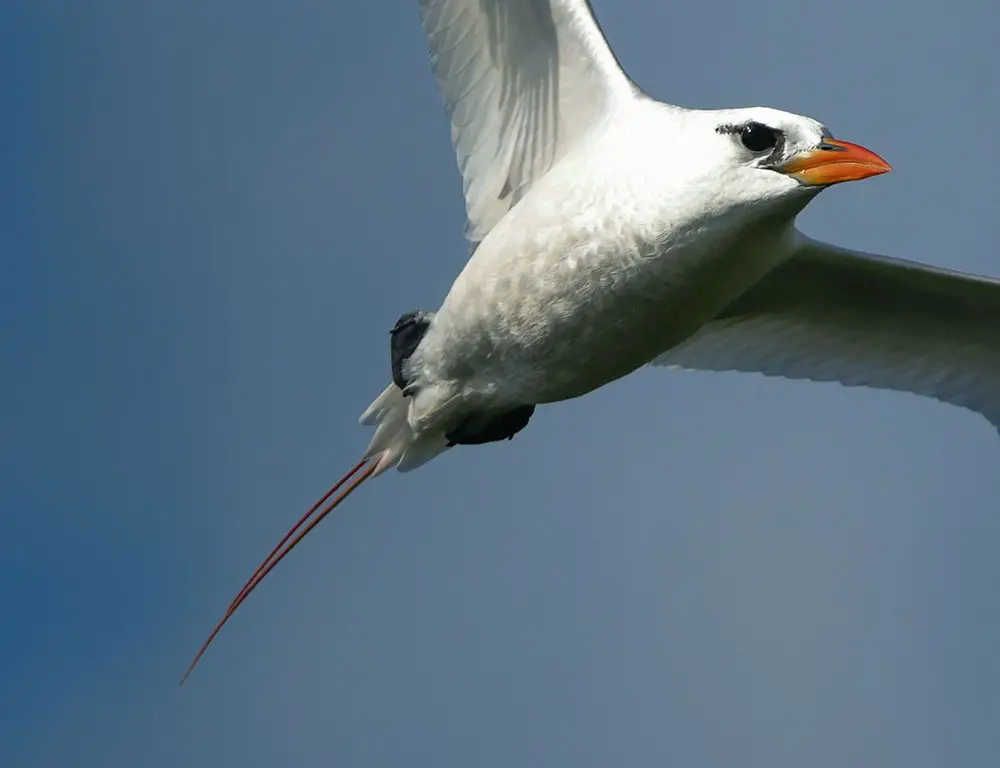
Although rarely seen because they spend most of their lives in flight or on remote nesting sites, Red-tailed Tropicbirds have short, webbed feet and legs adapted for perching on rocky cliffs or sandy shores.
Size
The red-tailed tropicbird, spanning 95 to 104 cm in length, boasts striking features including its distinctive 35 cm tail streamers.
Weighing around 800 g, this avian marvel sports a streamlined build and predominantly white plumage, occasionally tinged with pink. With a wingspan of 111 to 119 cm, it effortlessly navigates the skies, captivating observers with its elegant flight.
Distribution And Habitat
Red-tailed Tropical Birds are primarily found in tropical and subtropical oceans, particularly the Pacific, Indian, and Atlantic Oceans.
They typically inhabit remote islands, rocky cliffs, and atolls where they can nest safely away from predators and disturbances.
Behavior And Ecology
These birds are renowned for their graceful flight patterns and aerial displays, often soaring effortlessly over the ocean’s surface in search of prey.
They are predominantly solitary, only coming together during the breeding season or when congregating around abundant food sources.
Population
While specific population estimates vary, Red-tailed Tropicbird populations are generally considered stable, with some fluctuations in localized regions due to habitat loss or disturbance.
Threats
Despite their resilient population status, Red-tailed Tropicbirds face threats from human activities such as habitat destruction, pollution, and disturbance of nesting sites. Invasive species, such as rats and feral cats, also pose significant risks to their nesting success.
Evolution
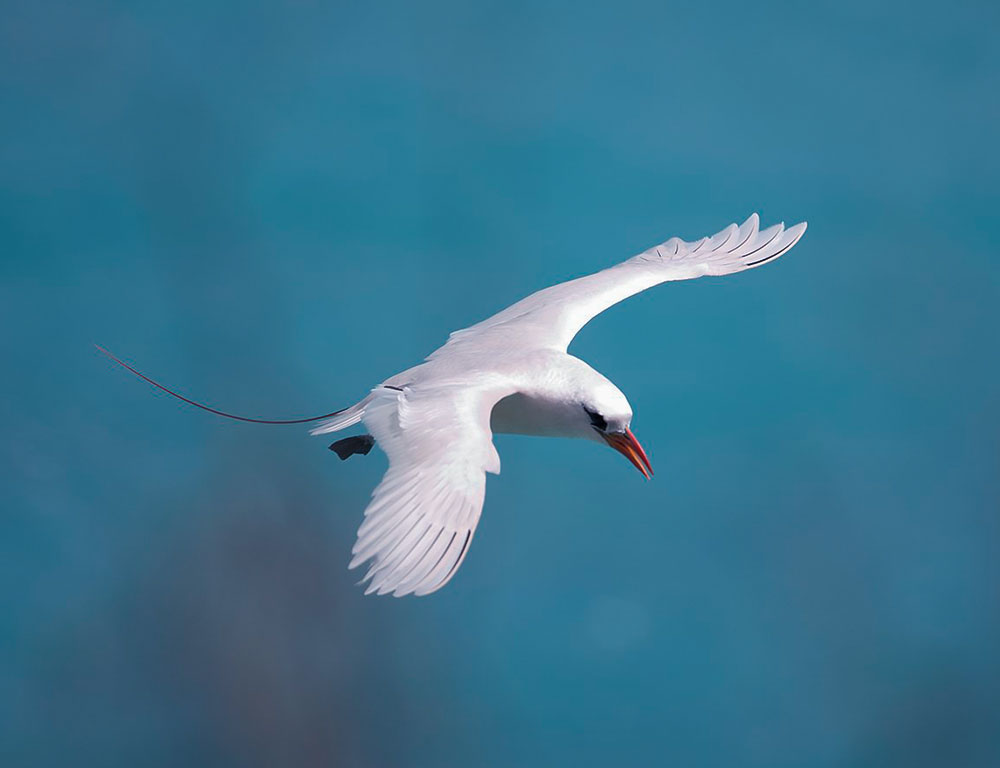
The evolutionary history of Red-tailed Tropical Birds traces back to their ancestors’ adaptation to oceanic environments, which led to specialized anatomical features and behaviors suited for life at sea.
Temperature Regulation
Adaptations for temperature regulation include specialized feather structures that provide insulation and help regulate body temperature in varying climatic conditions, essential for their survival in tropical and subtropical environments.
Relationship With Humans
Red-tailed Tropical Birds have fascinated humans for centuries, often featuring in indigenous myths and legends. Today, they attract ecotourism to some regions, providing economic benefits while facing challenges from habitat disturbance associated with tourism.
Taxonomy
Here’s a basic taxonomy table for the Red-Tailed Tropicbird:
| Kingdom | Animalia |
| Phylum | Chordata |
| Class | Aves |
| Order | Phaethontiformes |
| Family | Phaethontidae |
| Genus | Phaethon |
| Species | Phaethon rubricauda |
Nesting Habit
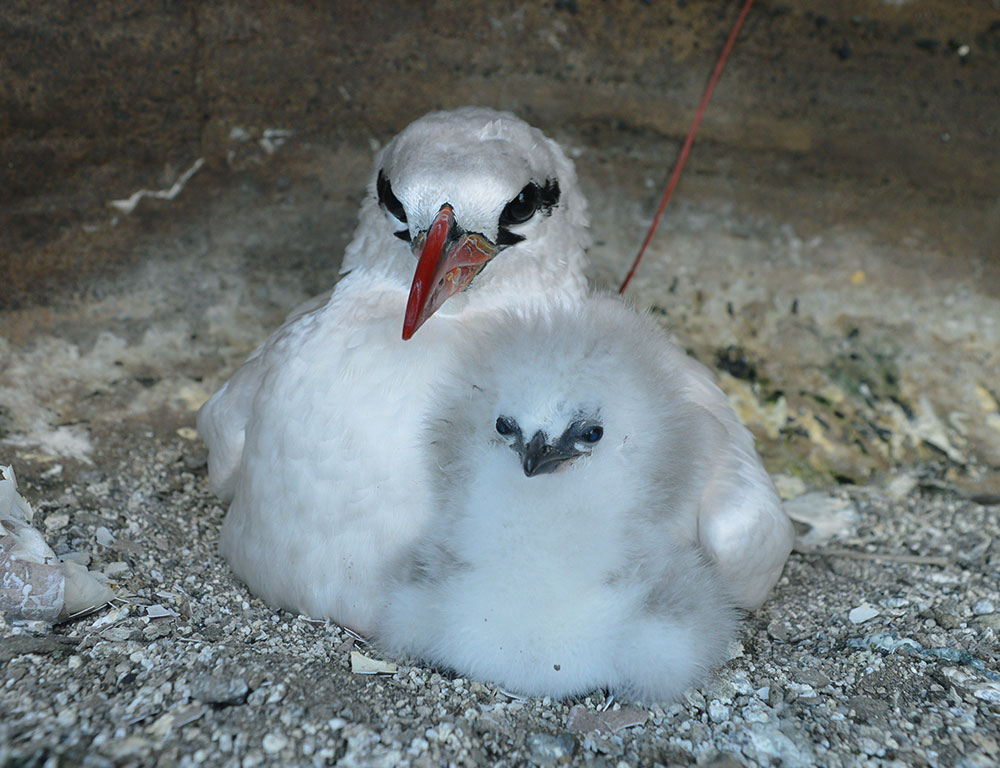
Here’s a table outlining the nesting habits of the Red-Tailed Tropicbird:
| Nesting Habit Feature | Description |
| Nesting Sites | Remote islands, rocky cliffs, and atolls in tropical and subtropical regions worldwide. |
| Nesting Material | They are often constructed with twigs, grass, and other vegetation, sometimes lined with feathers or debris. |
| Nesting Behavior | Form monogamous breeding pairs during the mating season and engage in elaborate courtship displays. |
| Nesting Season | Typically, they breed during specific seasons, depending on geographic location and climate. |
| Nesting Location | Nesting sites are typically chosen for their isolation and protection from terrestrial predators. |
| Nesting Colonies | May form colonies during breeding season, with individuals nesting near one another. |
| Nesting Incubation Period | The incubation period typically lasts several weeks, with both parents sharing incubation duties. |
| Nesting Chick-Rearing Duties | Both parents feed and care for the chicks until they fledge and become independent. |
Diet And Feeding
Their diet consists primarily of fish, squid, and other small marine creatures, which they catch by plunge-diving from the air or skimming the ocean’s surface with their bills.
Breeding
Breeding occurs in colonies on remote islands or cliffs, with pairs engaging in elaborate courtship displays involving aerial acrobatics and vocalizations. They typically lay a single egg per breeding season, with both parents sharing incubation and chick-rearing duties.
Status And Conservation
Red-tailed Tropicbirds are generally classified as species of Least Concern on the IUCN Red List. However, conservation efforts are still crucial to protect their nesting habitats and mitigate threats from human activities, invasive species, and climate change.
The Red-tailed Tropicbird exemplifies a fascinating blend of evolutionary adaptation, ecological significance, and cultural relevance, highlighting the complex interplay between these birds and their surrounding environment.
Ranging Map
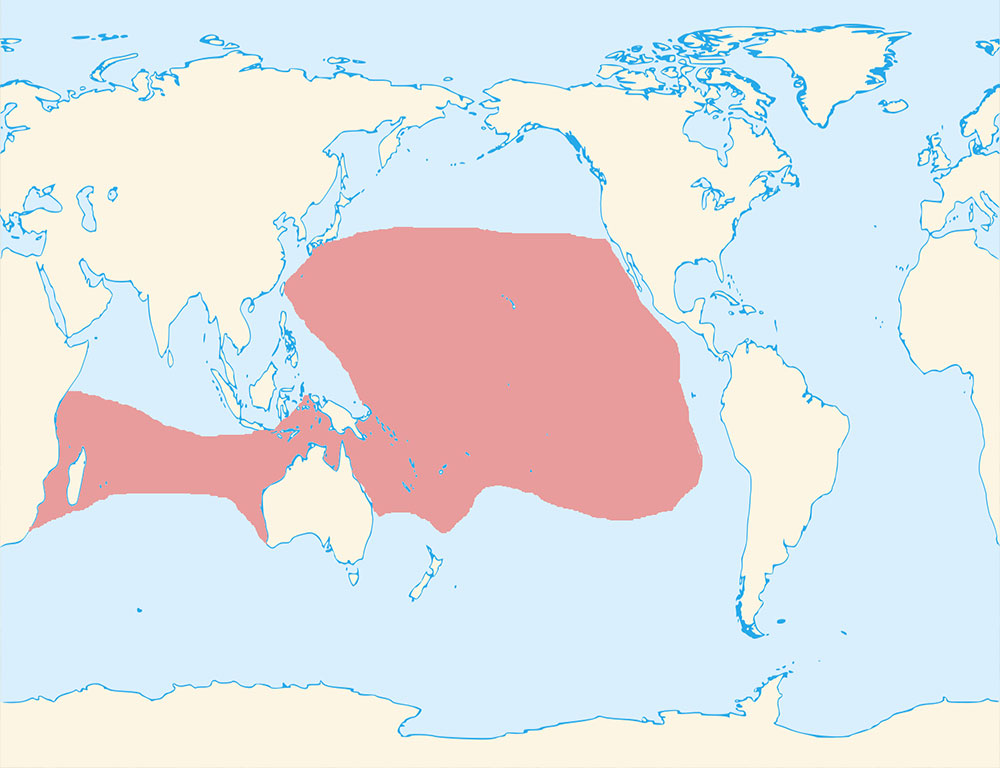
The ranging map of the Red-tailed Tropicalbird (Phaethon rubricauda) illustrates the expansive distribution of this remarkable seabird across tropical and subtropical regions worldwide.
With a broad range encompassing vast stretches of the Pacific, Indian, and Atlantic Oceans, these birds can nest on remote islands, rocky cliffs, and atolls far from mainland disturbances.
The map showcases the diverse habitats that Red-tailed Tropicbirds inhabit, from the lush tropical forests of volcanic islands to the arid, windswept shores of remote atolls.
Their distribution is often closely linked to the availability of suitable nesting sites and abundant food sources, such as schools of fish and squid congregating near oceanic currents.
How Do You Identify A Tropicbird?
Identifying a tropicbird, particularly the Red-tailed Tropicbird (Phaethon rubricauda), involves recognizing several distinctive features that set it apart from other seabird species.
These birds exhibit physical characteristics and behavioral traits that aid in identifying in various marine habitats.
Plumage Coloration
One of the most striking features of tropicbirds is their predominantly white plumage, which contrasts sharply with their black wingtips and tail feathers.
This distinctive color pattern, especially the vivid red hue of the tail feathers in the Red-tailed Tropicbird, is a key identifying trait.
Long, Streamlined Body
Tropicbirds have sleek, streamlined bodies designed for efficient flight over open water. Their elongated shape, combined with long wings and tail feathers, gives them a graceful appearance in flight, distinguishing them from other seabirds.
Long Tail Feathers
Tropicbirds are characterized by their exceptionally long tail feathers, extending well beyond their bodies’ length. These elongated tail streamers, especially prominent in species like the Red-tailed Tropicbird, are distinctive features that aid in their identification.
Slender, Decurved Bill
Another defining characteristic of tropicbirds is their slender, slightly decurved bills, adapted for capturing prey in flight. This specialized bill shape sets them apart from other seabirds and is well-suited for snatching fish and squid from the ocean’s surface.
Aerial Acrobatics
Tropicbirds are skilled aerialists capable of performing intricate flight maneuvers with ease. Their soaring, gliding flight patterns, and agile turns and dives are distinctive behaviors that help observers identify them even from a distance.
Crest And Facial Markings
Some tropicbird species, such as the Red-tailed Tropicbird, have prominent crests and distinct facial markings atop their heads. These features and bright eye coloration contribute to their overall appearance and aid in identification.
Habitat Preference
Tropicbirds are primarily pelagic birds, spending most of their time over open ocean waters. However, they come ashore to breed, often nesting on remote islands, rocky cliffs, or sandy shores.
Observing their nesting behavior and preferred habitats can help distinguish them from other seabird species.
Identifying a tropicbird involves recognizing physical attributes, including plumage coloration, body shape, bill structure, and behavioral characteristics such as aerial acrobatics and habitat preferences.
By paying attention to these distinctive features, birdwatchers and enthusiasts can confidently identify these elegant seabirds in their natural environment.
Interesting Facts About Red-Tailed Tropicbird
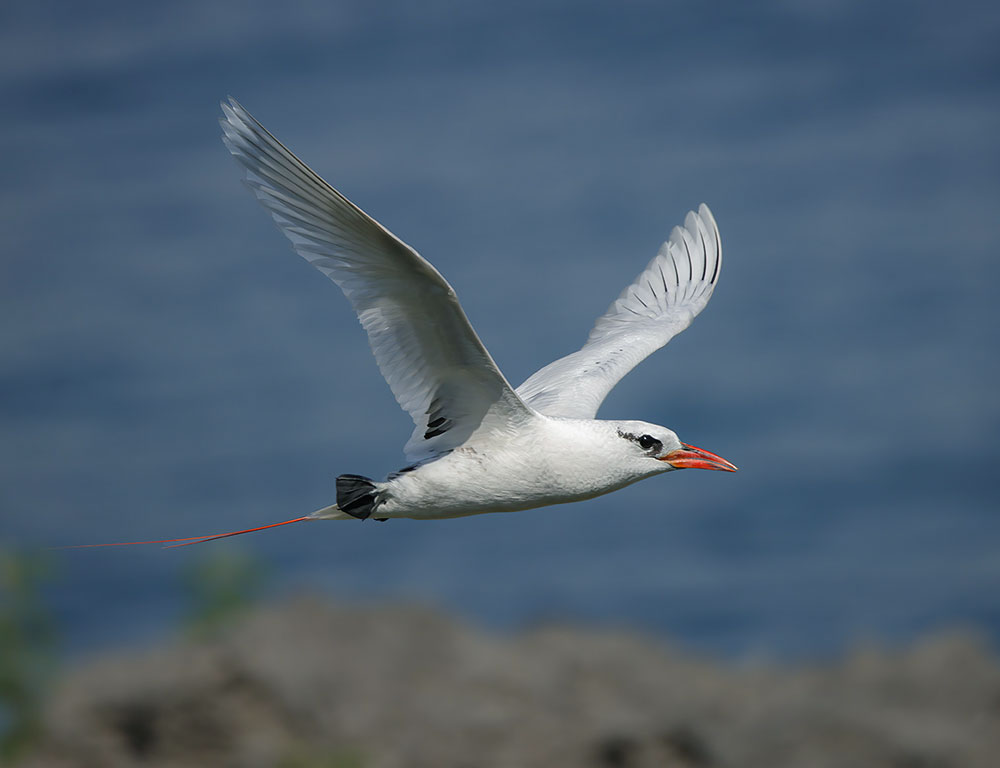
Here are 10 interesting facts about the Red-tailed Tropicbird:
Longest Tail Feathers
The Red-tailed tropical bird has some of the longest tail feathers in the bird kingdom, with streamers extending up to half a meter. These striking red feathers are prominent features during flight and courtship displays.
Monogamous Breeding Pairs
Tropicbirds, including the Red-tailed Tropicbird, typically form monogamous breeding pairs during the mating season. They engage in elaborate courtship rituals, which may involve aerial displays and vocalizations, to strengthen pair bonds.
Highly Aerial Lifestyle
Red-tailed Tropicbirds are superb aerialists, spending most of their lives in flight over the open ocean. They are known for their graceful gliding and soaring abilities, effortlessly riding air currents in search of food.
Remote Nesting Sites
These birds nest in remote and often inaccessible locations on offshore islands, rocky cliffs, or steep coastal slopes. Their nesting sites protect them from terrestrial predators and human disturbances.
Distinctive Vocalizations
Red-tailed Tropicbirds have a variety of vocalizations, including shrill whistles and harsh calls, which they use for communication within breeding colonies and during courtship displays.
Adaptations For Temperature Regulation
Their plumage and specialized feather structure provide insulation and help regulate body temperature, allowing them to thrive in the warm tropical and subtropical climates they inhabit.
Long-Distance Migrations
While Red-tailed Tropicbirds are primarily sedentary, some populations may undertake long-distance migrations in response to changing oceanic conditions or seasonal variations in food availability.
Conclusion
The Red-tailed Tropicbird is a testament to the wonders of the natural world, captivating all who encounter it with its beauty and grace. From its distinctive plumage to its remarkable aerial acrobatics, this seabird embodies the spirit of the tropical seas it calls home.
However, despite its apparent resilience, the Red-tailed Tropicbird faces threats from habitat destruction and human disturbances. Conservation efforts are crucial to safeguarding its nesting sites and ensuring the long-term survival of this iconic species.
As we strive to protect the habitats of the Red-tailed Tropicbird, we also preserve a symbol of the fragile yet resilient ecosystems of our planet’s oceans.
